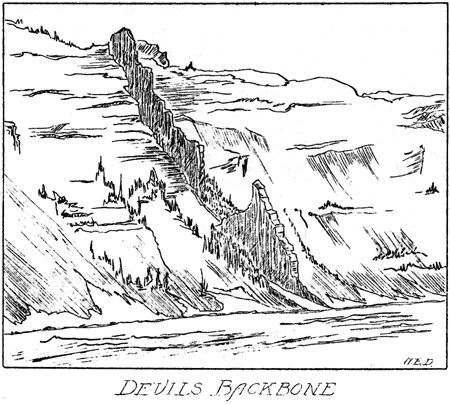|
Volume X No. 3 - August, 1937
Varved Clays Near The Devil's Backbone
By Randall E. Brown, Student Technician, 1937*

On the west rim of Crater Lake, approximately 600 feet south of the
Devil's Backbone and 200 feet below the rim of the crater, there is a
deposit of varved clays which resemble the typical varved clays
associated with glacial deposits.
These clays are limited in extent, the greatest exposure being
nearly six feet in thickness and thirty feet wide. Beyond, a mantle of
brush obliterates all trace of the clays. Farther south of the exposure
a lava flow rises above the elevation of the clay deposit. No trace of
the clays can be found either at that point or farther south.
The thick growth of brush is due to moisture issuing at the top of
the clay. Since the material above is definitely glacial in that it
consists of typical morainal debris, it accordingly is more porous than
the clay. The spring which supplies water for the North Entrance Ranger
Station issues at the top of the clay deposit. In general the structure
of the crater wall favors a westward drainage away from the lake;
however, there may have been a small basin in which the clay was
deposited which causes drainage toward the lake. Such a feature would
be only local in character.
In both directions, north and south of the exposed varved clays,
toward the Devil's Backbone and Hillman Peak respectively, the glacial
deposits are more sandy, although a few irregular sand clay layers may
be traced through the deposits. In several places, the most notable of
which occurs along the trail to the spring, there are deposits of well
stratified, water deposited sand. These glacial and fluvio-glacial
deposits are further evidence that the entire western slope of Mount
Mazama was covered by ice having a thickness of several hundred or
perhaps a thousand feet in places. Morainal deposits to the southwest
of Hillman Peak certainly indicate extensive glaciation on the west
slope of the ancient peak. Only Watchman and Hillman, the two peaks on
the west rim of Crater Lake may have projected above the ice sheet.
The varved clays rest on a series of lava flows. No glacial striae
were found on the surface of the flow directly beneath the clays. The
banding in the clays is uniform and regular, the varves being evenly
spaced. The varved character of the deposit indicates definitely
deposition of fine sediment in a body of quiet standing water. Such a
body of water may have existed during an inter-glacial stage, the water
being held in place by morainal material and the ice. During an advance
of the ice they clays, if frozen, may have remained undisturbed by the
overriding ice. There is also the possibility that the deposit
represents deposition in a dammed subglacial stream beneath stagnant
ice, in which case the glacial debris above the clays settled out of the
ice as it melted.
The section including the varved clays, the glacial drift above and
the underlying lava flows, was exposed when the peak of Mount Mazama was
destroyed.
*During the summer of 1937 the Civilian Conservation Corps
provided funds for employing college students majoring in some
particular field of work. Mr. Brown served as a Student Technician in
Geology, his activities being under the direct supervision of the
Naturalist staff of Crater Lake National Park.

| 
